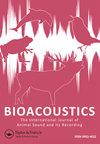一种基于卷积神经网络的蝙蝠叫声检测与分类方法的开发与测试
IF 2.1
4区 生物学
Q2 ZOOLOGY
Bioacoustics-The International Journal of Animal Sound and Its Recording
Pub Date : 2021-09-27
DOI:10.1080/09524622.2021.1978863
引用次数: 8
摘要
自动声学监测方法经常用于调查风力涡轮机周围蝙蝠的活动。该算法通常基于谱特征或记录的阈值。由于这些特征的通用性,很多录音都是噪音,使得手工分析和标记录音非常耗时。本文提出了一种基于卷积神经网络的蝙蝠叫声检测和分类方法。录音被转换为mel频率倒谱系数(mfccc),然后作为图像输入卷积神经网络(cnn)进行分类。使用在5 m高度收集的43585个记录组成的数据集来训练和测试该方法。在噪声和蝙蝠叫声的二元分类测试集上,准确率达到99.7%。对于物种分类,该方法的准确率达到96%。这两个网络都在5米高度收集数据进行训练,并在33米、65米和95米高度收集记录进行测试。在二元分类任务的情况下,结果显示噪声记录的错误分类率增加。在物种分类中,所有物种的误分类数量都较高。本文章由计算机程序翻译,如有差异,请以英文原文为准。
Development and test of a bat calls detection and classification method based on convolutional neural networks
ABSTRACT Automated acoustic monitoring methods are frequently used to survey bat activity around wind turbines. The algorithms are often based on spectral features or threshold values of the recordings. Due to the generality of these features, a lot of recordings are noise, making manual analysis and labelling of the recordings time consuming. In this paper, we present an approach based on convolutional neural networks to detect and classify bat calls respectively. Recordings are converted to Mel-frequency cepstral coefficients (MFCCs), which are then fed as an image into the convolutional neural networks (CNNs) for classification. A dataset consisting of 43585 recordings gathered at 5 m height was used to train and test this method. An accuracy of 99.7% was achieved on a test set for the binary classification of noise and bat calls. For the species classification, this approach achieved an accuracy of 96%. Both networks, trained on data gathered at 5 m, were also tested on recordings gathered at heights of 33 m, 65 m and 95 m. In case of the binary classification task, the results showed an increased rate of misclassifications among noise recordings. For species classification, there was a higher amount of misclassifcations among all species.
求助全文
通过发布文献求助,成功后即可免费获取论文全文。
去求助
来源期刊
CiteScore
4.50
自引率
0.00%
发文量
25
审稿时长
>12 weeks
期刊介绍:
Bioacoustics primarily publishes high-quality original research papers and reviews on sound communication in birds, mammals, amphibians, reptiles, fish, insects and other invertebrates, including the following topics :
-Communication and related behaviour-
Sound production-
Hearing-
Ontogeny and learning-
Bioacoustics in taxonomy and systematics-
Impacts of noise-
Bioacoustics in environmental monitoring-
Identification techniques and applications-
Recording and analysis-
Equipment and techniques-
Ultrasound and infrasound-
Underwater sound-
Bioacoustical sound structures, patterns, variation and repertoires

 求助内容:
求助内容: 应助结果提醒方式:
应助结果提醒方式:


